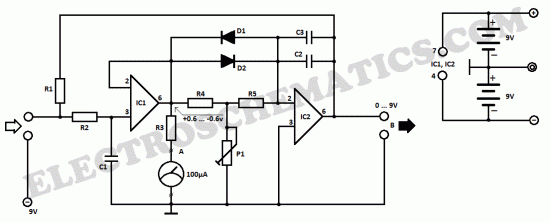 This electronic lie detector circuit will give two readings: one for difficult questions for the subject and another to show its emotional state in general. This electronic lie detector circuit will give two readings: one for difficult questions for the subject and another to show its emotional state in general.
The emotional states are detected not only by heart beat accelaration and trembling hands but also an increase in skin humidity whose resistance decreases causing the entry into operation of the lie detector.
Two electrodes can be used as a flexible wire, bare, wrapped around fingers or wrist.
In order to not influence the measurement result the device must be powered from two 9 Volts batteries.Each change in resistance, and therefore the voltage at the input circuit will be amplified by operational amplifier A1, which also serves as separator. The output signal will determine, by R3, a deviation of the measuring instrument. General emotional state of a person can be assessed by measuring the average resistance of the skin over a period of time. The indication is provided by an indicator instrument connected to point B of the circuit. Operational amplifier A2 is connected as an integrator and allows the circuit to automatically adjust according to the average resistance of the skin. Length of time to measure the skin resistance is determined by R5, C2 and C3. Until such time elapses, the lie detector gives no indication although diodes D1 and D3 provide a rapid response of the circuit.
Potentiometer P1 allows you to adjust the time delay of the circuit. Since skin resistance varies from one person to another, may be necessary to change the resistance value R1. This resistance can be replaced with a potentiometer. Reading a great value to the instrument connected to the output of B indicates that subject’s skin resistance is low (which is a characteristic of people with sticky hands) and it is advisable to reduce the value of R1. lie detector components list
R1 = 47K
R2 = 1M
R3 = 3.3K
R4 = 10K
R5 = 10M
P1 = 10K
C1 = 100n
C2 = C3 = 470n
D1 = D2 = 1N4148
IC1 = IC2 = LF356
| 




